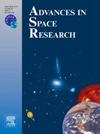Understanding northeastern tropical atlantic ocean dynamics in relation to climate indices
IF 2.8
3区 地球科学
Q2 ASTRONOMY & ASTROPHYSICS
引用次数: 0
Abstract
Since 1993, Satellite Altimetry greatly enhanced the ability to study and understand ocean dynamics, particularly in the context of climate change. Though relatively low-energy and understudied, the Northeast Tropical Atlantic Ocean (NTAO) plays a crucial role in the Earth’s climate system. This study aims to deepen understanding of the NTAO region using the satellite altimetry-derived daily sea level gridded data set provided by the Copernicus Climate Change Service (C3S).
The analysis of long-term regional Sea Level Anomaly (SLA) signals in the NTAO reveals a higher rate of sea level rise compared to the global average. The same analysis for regional Eddy Kinetic Energy (EKE) per unit mass and surface geostrophic currents shows declining rates, in contrast to global counterparts.
Correlation analysis between SLA and climate indices (CI) uncovered significant links with the North Atlantic Oscillation, Tropical North/South Atlantic, Western Hemisphere Warm Pool, and Southern Oscillation Index. Composite maps of sea surface temperature (SST), sea level pressure (SLP), and wind anomalies, as well as complementary maps with anomalies of SLA, EKE, and ocean circulation, were examined to understand the primary mechanisms behind these correlations. SST emerged as the main forcing factor, with SLP and wind anomalies also contributing to specific regional and index correlations. EKE anomalies further elucidate differences in the anomalies of the surface geostrophic currents in the areas influenced by the key currents in the study region. The findings of this study show an intricate interplay between oceanic dynamics and climate phenomena, shedding light on the complex mechanisms driving changes in the Northeast Tropical Atlantic Ocean.
求助全文
约1分钟内获得全文
求助全文
来源期刊

Advances in Space Research
地学天文-地球科学综合
CiteScore
5.20
自引率
11.50%
发文量
800
审稿时长
5.8 months
期刊介绍:
The COSPAR publication Advances in Space Research (ASR) is an open journal covering all areas of space research including: space studies of the Earth''s surface, meteorology, climate, the Earth-Moon system, planets and small bodies of the solar system, upper atmospheres, ionospheres and magnetospheres of the Earth and planets including reference atmospheres, space plasmas in the solar system, astrophysics from space, materials sciences in space, fundamental physics in space, space debris, space weather, Earth observations of space phenomena, etc.
NB: Please note that manuscripts related to life sciences as related to space are no more accepted for submission to Advances in Space Research. Such manuscripts should now be submitted to the new COSPAR Journal Life Sciences in Space Research (LSSR).
All submissions are reviewed by two scientists in the field. COSPAR is an interdisciplinary scientific organization concerned with the progress of space research on an international scale. Operating under the rules of ICSU, COSPAR ignores political considerations and considers all questions solely from the scientific viewpoint.
 求助内容:
求助内容: 应助结果提醒方式:
应助结果提醒方式:


